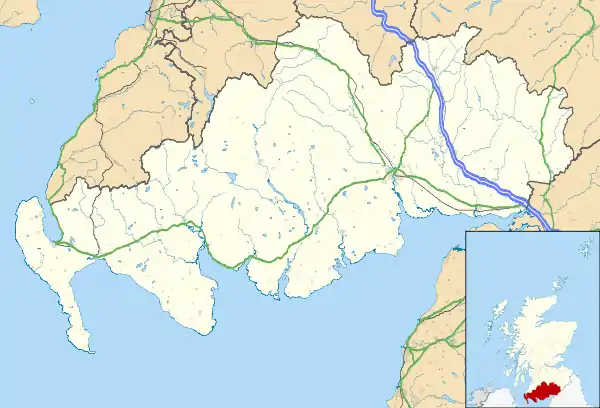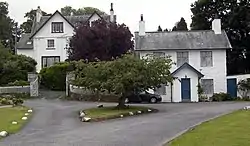Gatehouse of Fleet
Gatehouse of Fleet (Scots: Gatehoose o Fleet Scottish Gaelic: Taigh an Rathaid) is a town in the civil parish of Girthon, Kirkcudbrightshire, within the district council region of Dumfries and Galloway, Scotland, which has existed since the mid-18th century, although the area has been inhabited since much earlier. Much of its development was attributable to the entrepreneur James Murray's decision to build his summer home, Cally House there in 1763. The house is now the Cally Palace Hotel.
Gatehouse of Fleet
| |
|---|---|
 Gatehouse of Fleet Location within Dumfries and Galloway | |
| OS grid reference | NX597561 |
| Council area | |
| Lieutenancy area | |
| Country | Scotland |
| Sovereign state | United Kingdom |
| Post town | CASTLE DOUGLAS |
| Postcode district | DG7 |
| Police | Scotland |
| Fire | Scottish |
| Ambulance | Scottish |
| UK Parliament | |
| Scottish Parliament | |
Over the next hundred years, the town developed into a centre for industry, particularly cotton mills. The western approach to the town is dominated by the imposing Cardoness Castle. Gatehouse of Fleet is the birthplace of Victorian artist John Faed. The renowned inventor of clockwork mechanisms, Robert Williamson, was also known to have set up a workshop in the town in 1778, which burned to the ground in 1794, killing him.
The town takes its name from its location near the mouth of the river called the Water of Fleet which empties into Wigtown Bay at Fleet Bay, and its former role as the "Gait House" or "the House on the Road on the River Fleet" or toll booth of the late 18th century stagecoach route from Dumfries to Stranraer, now the A75 road. It was a haven along this route, and travellers would often stop in the area rather than furthering the journey at night due to the high numbers of bandits and highwaymen at the time.
Cally House was designed by Robert Mylne and built in 1763. The house was sold in 1933 and became a hotel, which opened in 1934. It was used as a residential school for evacuees from Glasgow during the Second World War, reopening as an hotel in the later 1940s.
The settlement of Anwoth is one mile (1.5 km) to the west of Gatehouse of Fleet; this is where Samuel Rutherford was minister from 1627 to 1636.
Gatehouse has the second oldest average population of towns in Scotland.
Jeanie Donnan, (1864-1942), "The Galloway Poetess", was born here before moving to Whithorn in Wigtownshire where she lived on George Street and where she is commemorated by a plaque. She wrote poetry about local events. Her works include Hameland: The Poems of Jeannie Donnan, 1907; War Poems, 1915; The Hills of Hame, 1930. Many of her poems were also published in the Galloway Gazette.[1]
Church of the Resurrection, 1971 designed by Sutherland, Dickie & Copland. The church is lit by a dramatic clerestory window. Metal sculptures of the Resurrected Christ and Our Lady by Liverpool artist Arthur Dooley (1929-1994) formerly on the sanctuary wall.[2] Since the closure of this church on 1 February 2020 and ahead of its demolition, the sculptures have been removed to St Andrew and St Cuthbert Church in Kirkcudbright.
The Swallows is an artwork created in willow by local artist Lizzie Farey and was a memorial commission.[3] The last Mass was celebrated on 1 February 2020 by the Bishop of Galloway, William Nolan and parish priest Rev Fr William McFadden. The church will be demolished and the site sold for housing.[4][5]
Part of the action of Five Red Herrings, a 1931 Lord Peter Wimsey detective novel by Dorothy L. Sayers, takes place in Gatehouse of Fleet.
Notable people
- Joe Ansbro the rugby player was raised near Gatehouse of Fleet and attended Gatehouse Primary School .
- Katrina Bryan, the "Nina" of the CBeebies show Nina and the Neurons, was born in the town in 1980.
- John Faed, James Faed, Thomas Faed, Boab Patterson-Faed and Susan Faed, members of the celebrated family of Victorian artists, were all born at Barlay Mill, Gatehouse of Fleet.
- Catherwood Learmonth FRSE (1896-1981) spent his early life here
- Hamish MacInnes, the well known mountaineer and pioneer of mountain rescue in Scotland was born in the town in 1930.[6]
- Sir John McMichael FRSE (1904-1993), Professor of Medicine at Hammersmith Hospital, London, Director of the British Postgraduate Medical Federation and a trustee of the Wellcome Trust, was born in the town.
- Richard Gilbey, 12th Baron Vaux of Harrowden.
Provosts
Gatehouse of Fleet had a provost for part of its history: These included:[7]
- Robert Veitch, 1951-1958
- Wilfred Davidson, 1962-1966
Attractions

Gatehouse of Fleet sits at the bottom of the Fleet Valley National Scenic Area (NSA). Cairnsmore of Fleet National Nature Reserve (NNR) is located at the top of the Water of Fleet catchment.[8] Garries Park is central to Gatehouse of Fleet. There is a restored mill next to the River Fleet, "The Mill on the Fleet." The road also leads to an attraction of historical significance, Cardoness Castle. Beaches near the town can be found at Carrick and Sandgreen. The Cream o' Galloway[9] offers a major visitor attraction. The Clints of Dromore[10] near the old Gatehouse of Fleet railway station provide rock-climbing.
References
- "Famous Sons and Daughters". Royal Burgh of Whithorn & District Business Association. Retrieved 18 August 2020.
- "Church of the Resurrection, Gatehouse of Fleet". 24 September 2017.
- "Gatehouse Art Work - St Andrew's and St Cuthbert's, Kirkcudbright". Roman Catholic parishes in Dumfries and Galloway. Archived from the original on 25 August 2019. Retrieved 3 February 2019.
- Norris, Stephen (28 January 2020). "Last mass for Gatehouse church". Daily Record. Retrieved 2 February 2020.
- Gillespie, Stuart (6 February 2020). "Church closes with Thanksgiving Mass". Daily Record. Retrieved 11 February 2020.
- Fraser, Robbie (Producer/Director) (2019). Final Ascent: The Legend Of Hamish MacInnes. Bees Nees Media Ltd. 19:40 minutes in. Retrieved 23 April 2020.
- http://www.gatehouse-folk.org.uk/detailpage.asp?d=149&ID=12
- "Deliciously Good! | Cream o' Galloway". www.creamogalloway.co.uk.
- "Clints of Dromore Outbye, Fleet Valley". Walkhighlands.
External links
| Wikimedia Commons has media related to Gatehouse of Fleet. |
